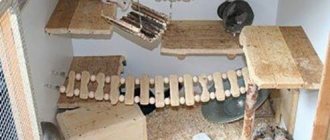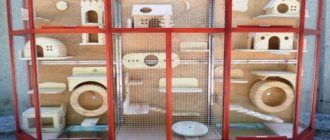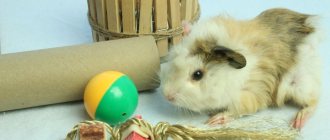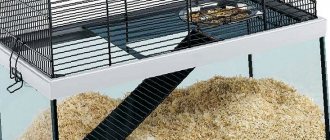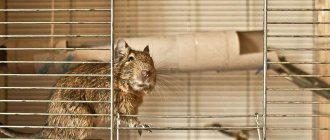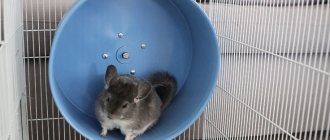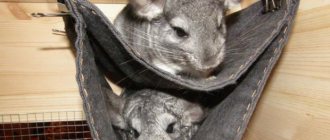Before buying a chinchilla, you need to take care of where it will live. Usually, for this purpose, a cage is chosen, inside which a house and other accessories are installed.
How are homemade cages and houses different from those you can buy in a store? Almost everyone. After all, they will definitely be filled with warmth and care for the pet. Here you are the designer and performer. Any idea, any size plus a little effort – done! Nothing compares to something like this.
In this article we will look at how to make a cage for a chinchilla with your own hands, we will look at the best materials to choose and what ideas and manufacturing technologies exist.
Requirements
When choosing any item, there are special things that you need to pay attention to, the same with the cage. What kind of cage should a pet be comfortable in?
Primary requirements:
- spacious. Chinchillas are very active animals; they love to jump and run. Therefore, cell size is an important criterion when choosing. The pet should be comfortable;
- Made from non-toxic materials. An important criterion is the choice of material. It should not be plastic or similar materials (with the exception of a pallet);
- safe. There should be no sharp edges, wires or other dangerous elements inside the cage. Even a small wire from the wall bars, bent inward, can injure the animal;
- it should be possible to easily and safely install shelves, drinking bowls, toys and other items that your pet needs so much;
- have good ventilation;
- sufficient lighting;
- It is desirable to have a tray, this will make it easier to clean inside.
Care and maintenance at home
When you decide to get a chinchilla, it is important to first learn how to care for your pet at home. Proper care and rational feeding are the key to a long life for an animal.
Pet cage and house
Before purchasing a chinchilla, you need to purchase a home for your future pet. It is preferable to keep the animal in a cage, the main criterion for choosing which is spaciousness. The chinchilla is a mobile, active animal that requires enough space. The minimum cage size for one individual is 50x60 cm, excluding the play area. The choice should be made in favor of high cages, since the rodent is characterized by jumping ability.
It is worth paying attention to the material from which the rods are made: they must be metal. The pet will quickly chew through wooden or plastic grilles and run away. Since the chinchilla is flexible, you should not buy a cage with a large distance between the bars, this also risks the animal escaping
Since the chinchilla is flexible, you should not purchase a cage with a large distance between the bars, as this also risks the animal escaping.
Metal cages with a plastic tray are the best solution when purchasing a house for a future pet; they are easy to clean and inexpensive. However, they are not soundproofed; this will be especially noticeable at night. As an alternative, pet stores offer to place the animal in special glass display cases made like an aquarium.
Disadvantages of the showcase:
- the wooden frame absorbs unpleasant odors;
- inconvenient to wash;
- The walls and floor swell from moisture over time, resulting in the need to replace the display case.
Inside the rodent's home, it is necessary to install a wooden house in which the animal will sleep during the daytime and hide from the outside world.
Delicious dinner!
How to maintain?
Keeping a chinchilla will not be particularly difficult if the pet owner takes care of purchasing a spacious cage furnished with the necessary accessories. The animal must be kept clean and always have access to clean water, hay and fresh food.
It is important to monitor the thermal regime; exceeding the air temperature of 25 degrees is fraught with heat stroke for the animal. You can beat the seasonal heat by placing frozen water bottles in your cage. This will cool the temperature inside the animal's home.
It is under no circumstances recommended to install a fan or humidifier in a room with a chinchilla.
This will cool the temperature inside the animal's home. It is under no circumstances recommended to install a fan or humidifier in a room with a chinchilla.
In addition to the house, feeder and drinking bowl, the cage must contain a special salt stone on which the animal will grind its teeth. For entertainment, you can equip the cage with a system of manholes and tunnels, which can be purchased at a pet store.
How to toilet train?
Chinchillas are easy to train; if desired, you can accustom them to a tray that serves as a toilet. Preference should be given to the corner option, this will save space in the cage.
To train an animal to relieve itself only in a tray, you should fill it with a special wood filler and regularly collect the animal’s pellets in it. Feeling the smell, over time the chinchilla will understand that the tray is a special place for excrement.
When training your pet to use the toilet, it is important to adhere to the basic rules of training - reward while visiting the litter box and scold for defecating on the floor.
Bathing
The rodent's soft coat requires regular bathing in special seliolite sand, which can be purchased at a pet store. This procedure allows you to clean the animal’s fur from dirt.
Bathing a chinchilla should be carried out in a special bathing suit, on the bottom of which sand is poured in a layer no higher than half a centimeter
It is important that the product is securely fastened to the bars of the cage, so that the vigorous movements of the rodent do not lead to the bathing suit turning over
Bathing a chinchilla
How to care for a sick pet?
Chinchillas, like any representative animal of the animal world, can get sick. The main signs of animal illness are:
- inactivity;
- apathy;
- increased sleepiness at night;
- excessive salivation;
- moans;
- refusal of food;
- pressing the ears to the head.
Any of these symptoms is a good reason to contact your veterinarian. You should not try to treat the animal yourself; only a doctor who will give basic recommendations for caring for a sick pet should make a diagnosis and prescribe a treatment regimen. The owner’s main task during this period is to strictly follow the veterinarian’s recommendations.
Main varieties
When looking for a home for your pet, you can find different variations of cages. They differ in appearance, price and quality.
Let's look at the most common options.
From metal rods
This is the most common and very budget option. At the bottom of such a cage there is usually a tray with sawdust, which is easy to clean. It is easy to attach the necessary accessories for your pet to the mesh. But this design does not dampen noise at all; any movement in it will make sound.
Display cage
The material usually used is wood, although other models are also available. Such a cage is a real work of art and the pet becomes part of this composition. It will easily fit into the interior and complement it.
From old furniture
Masters can give a second life to any item. Unnecessary furniture in their hands turns into a beautiful display cage.
For breeding chinchillas
This design is a metal cage divided into several sections, each of which houses a pet.
Original ideas
Creative owners of furry pets offer interesting options for making multifunctional houses. So, one of them is a house combined with a hay barn: shelter - one, material for gnawing - two, a place for hay placed between the sticks - three. To make such a product you need a minimum of materials:
- board as a roof,
- dry birch or hazel sticks (due to the density of this type of wood, the chinchilla will chew them longer),
- a block for fastening them,
- small screws, screws or nails - for the same purpose.
When finished, the house looks like a nice and quite cozy hut for a rodent.
You can make a special “gnawing” house for your pet from branches and wooden scraps, fastening them with the same connecting parts.
Below are the drawings of the houses - several options.
Homemade houses are also an economical option. If you build an entire cage or display case for a chinchilla with your own hands, its total price will be several times lower than the store price. So, dear craftsmen, get a jigsaw in your hands!
Dimensions
As mentioned above, size is important. How comfortable the animal will be depends on it; its health directly depends on it.
For one animal
It is advisable to choose a cage with dimensions of 80x80x50 cm. With such dimensions the pet will not feel cramped. But still, acquiring a more spacious living space will only be a plus.
For two chinchillas
The size of the cage must be at least 140x140x80cm.
For breeding
The size of the cage should be much larger than normal. Such farmer cells are an amalgamation of smaller cells. It is desirable that each such cell be 50x50x40 cm in size. It is necessary to build a corridor between them so that the male can calmly pass to the females. At the same time, isolate the females from each other. This can be done by putting special plastic collars on the females.
Types, shapes and types of houses for chinchillas
What types of houses for chinchillas can you find: made of wood, ceramics and plastic, straw and even twine. The last two options are chewed by chinchillas in a few weeks. In this regard, wooden ones will last longer.
The configurations of the houses are round, triangular, oval and rectangular. Projects in the form of wooden huts, medieval castles, and Indian wigwams look interesting.
You can choose any model based on financial availability and ideas about aesthetics. There are several criteria that must be adhered to:
- sizes are selected depending on the size of the chinchilla;
- the structure should not have holes or other places where a rodent’s paw could get stuck;
- In addition to the entrance, it is necessary to provide a window for ventilation;
- the most convenient for cleaning is the design without a bottom;
- The flat roof of the house is safe, from which the pet cannot fall;
- There should be no protruding nail heads, burrs or other dangerous protruding elements on the walls.
The corner design of the shelter looks compact and cozy and fits well into the interior of the animal’s home. The corner area in a chinchilla cage is psychologically associated with protection. That's why? Your pet will definitely like this project.
When a couple lives in a cage, there are two options: put one spacious house with two entrances or two nearby. The choice depends on the characters of the pets and the degree of their affection for each other. If you notice that even if there are two shelters, they tend to fit into one, you need to meet your friends halfway and put up one house of normal size.
Pros and cons of a homemade cage
There is a wide range of cages in stores, but sometimes even there you can’t find anything suitable. Making a cage for a chinchilla yourself is an excellent option for craftsmen and simply loving owners. A chinchilla's cage must have a certain size. Knowing the manufacturing technology, you can make it in just a couple of hours.
Any homemade item has pros and cons. Let's pay attention to them.
Pros:
- low cost;
- confidence in the quality of materials;
- the ability to design the design, dimensions and material of the cage yourself;
- can be made from available materials.
Minuses:
- to quickly build a cage, you need to have some skills;
- you will have to buy consumables.
Cell project
Rodents are very mobile and active, and they also do not like to live alone. Therefore, they need a spacious, possibly multi-story cage, various labyrinths and a wheel.
Considering the size, remember that at least 75x35x50cm is required for one animal. If you have no idea what the design should look like, you can look at photos of chinchilla cages on the Internet.
Tall multi-story structures are better suited for apartments. In private homes, you can afford a larger size and place a lot of toys in it.
We do not recommend immediately taking on complex projects with a large number of loopholes. A much better solution would be a lighter design that you can redo over time. Drawings and diagrams for creating cells can be found on the Internet.
Metal mesh cage
A cage made of metal mesh is the simplest option that you can make yourself at home.
Required materials and tools
To create such a house you will need the following:
- metal mesh (roll). Must be galvanized;
- metal tubes for the frame;
- fastening rings;
- bolts for locking;
- self-tapping screws;
- aluminum strip (corner);
- aluminum wire;
- scissors for cutting metal;
- centimeter tape measure;
- pliers;
- screwdriver;
- latch;
- loops.
Dimensions and layout
The minimum length and width of the house must be at least 50 cm. Its height must be 70 cm. The distance between the rods must be no more than 2 cm.
If two pets will live in the house, then it should have a place for sleeping, playing and active movement. There should be enough space to accommodate all the necessary elements for a comfortable life for pets.
Do-it-yourself housing for a chinchilla
Often breeders decide to make a chinchilla cage with their own hands.
If you have a desire to tinker, then here are a few instructions to help you. First, buy the necessary materials for the job. It is better to give preference to wood. The frame will be made of bars, lining, boards and many shelves. Chipboard or plywood are also suitable. To close the holes, you need a metal mesh.
The following tools will be useful:
- hacksaw;
- jigsaw;
- hammer;
- drill and wood bits;
- stationery knife, marker;
- metal scissors;
- ruler.
To begin, prepare a drawing, taking into account the size of your room and the size of the desired pet house. Then start making the base, which needs to be covered with clapboard.
Next, the cage frame is built from the bars.
The bars are attached to the corners of the base using self-tapping screws or nails.
Using a metal mesh, the walls of the cage and its roof are tightened.
To make cleaning easier, we recommend making several doors on different sides.
Then you can install various shelves and place the accessories your animal needs on them.
It is best to cover the back of the cage with a sheet of plywood.
Finally, it is necessary to treat the house with a protective impregnation.
If you show your imagination, you can use old furniture and other available materials. An old cabinet is often used:
- The doors are removed from the furniture and the inside is repurposed for animals. Some of the shelves are cut out to allow animals to move freely.
- You need to cut a hole in the top of the closet and stretch the mesh so that the house is ventilated.
- In place of the cabinet doors, you can make frames from wood and tighten them with a metal mesh.
A do-it-yourself chinchilla display “from scratch” will require a little more time and skill.
So, you will need:
- metal tubes for the frame, or wooden yards;
- corners to connect parts;
- cogs;
- metal mesh;
- door hinges.
Then follow the instructions step by step:
| Step | Description |
| 1. | First you need to prepare drawings, taking into account the minimum acceptable dimensions for a chinchilla cage. |
| 2. | Next, we assemble the frame from pipes and yards, using corners for reliability, and fasten them with screws. |
| 3. | Make (internal) markings, designating areas for the animal’s life, that is, think about a place for sleeping, playing, toilet, bath, etc. |
| 4. | The mesh bottom is attached to the cage frame. For this you need a welding machine. |
| 5. | Connect the frame and walls of the house. |
| 6. | Next you need to install the door, use hinges and a lock. |
| 7. | Attach accessories inside the house. |
A do-it-yourself corner display case for a chinchilla is quite popular, because it can significantly save space in your apartment. To make one, show a little imagination and dexterity, and the result will definitely please you!
Where to place a chinchilla cage
Take seriously the choice of place in the apartment where the cage with the animal will be placed. It is better not to change the location of the cage throughout the animal’s life.
Here are some tips for you:
- the room should be dry and light;
- direct rays of the sun should not enter the cage;
- drafts should not be allowed;
- the air temperature where the animal lives should not exceed +23° C.
- the cage should not be placed next to electrical heating appliances;
- It is not advisable to place the cage on the floor;
- the cage should not be placed next to loud devices (equipment);
- Since chinchillas are very active at night, you should not place the cage in the bedroom. It's better to put it in the living room.
Cleaning a chinchilla's cage or display case
It is not enough to simply make a house, choose a place for it and move your pet into it; you must also not forget about caring for your pet’s home. Once a week you need to do a general cleaning, and at this time the animal should be placed in a carrier. The house can be wiped with a wet cloth and even vacuumed. At the end of cleaning, you need to wipe the cage dry. Disinfection (if necessary) is carried out using specialized products purchased at a pet store.
Step-by-step instruction
Drawing up a drawing
The drawing must be drawn up taking into account the dimensions of all parts. It is important to calculate how many aluminum profiles will be needed in length and how much mesh will have to be spent on the side walls. Be sure to calculate the dimensions of the upper part of the structure. You also need to decide on the number of shelves.
Frame assembly
Assemble a frame from metal tubes according to the drawing. Spread the net on the table and use a tape measure to measure the distance corresponding to the height. Cut out the sides from the mesh and align them.
Connecting elements
Using fastening rings, attach the mesh to the frame. Cut out the roof and bottom from the wall. Attach them to the frame. At the bottom you can lay a piece of tin with sawdust, which will serve as a pallet.
Door installation
Involves performing the following actions:
- To make a door, just cut a window in one of the walls. The edges of which need to be sanded and then trimmed with aluminum strips.
- The mesh cut to the size of the window must also be trimmed and attached to the hinges. This design closes with a latch.
Another, more simplified way:
- Cut a window in one of the walls. Trim the edges.
- Attach the mesh cut to the size of the window onto hooks made of aluminum wire.
Attaching accessories:
One cage is not enough for a comfortable life. The pet needs a house, a bowl, toys, a tray, a bath, and a teeth sharpener. All this can be installed on shelves that can be easily attached to the mesh wall using small metal corners or screws. A hammock in a cage with metal rods can be hung from hooks from the ceiling. The drinking bowl and hay box are simply attached to the walls.
A display cage can be incredibly unusual, because there is no end to the design possibilities. It looks much more beautiful than a regular cage. In addition, this model creates virtually no noise. To find out how to make a chinchilla display, you can look at the drawings on the Internet.
Exercise for chinchillas
Physical inactivity is very dangerous for such an active animal. An active lifestyle for a chinchilla is the key to a successful, healthy, long life, and a responsible, caring owner should not forget about this. The ability to constantly move is necessary for the normal functioning of the animal’s intestines and cardiovascular system. First of all, you need to install a training wheel in the cage. The wheel must be solid, but not wire, otherwise the animal’s paws can easily get stuck in it. Hamster wheels are not suitable for chinchillas. When walking a rodent in an apartment or house, you should do this in a small room without an excess of foreign objects that could be dangerous for the animal. These animals jump quite high; They can crawl into very narrow cracks and chew wires and furniture. All these risk factors should not go unnoticed during a free walk.
Display cage made of laminated chipboard
Such a chinchilla house can be made using laminated chipboard as a basis. It is important to remember that the area must be dry, have sufficient lighting and good ventilation.
What the result should be, look at the photo below:
Required materials and tools
To build a display case for a chinchilla, you will need the following:
- laminated chipboard;
- pencil;
- centimeter tape measure;
- wooden slats (or aluminum profile);
- wooden boards;
- glass;
- galvanized mesh (mesh size 1.5×1.5 cm);
- PVC tape;
- hinges for doors;
- screws;
- latches;
- drill;
- self-tapping screws;
- screwdriver;
- drill;
- jigsaw;
- saw.
Stages of creation
When everything is prepared, you can begin the creation process.
To do this you need to do the following:
- First take your measurements. Build a drawing.
- Draw the walls and bottom of the required dimensions on the chipboard, cut them out.
- Cut out windows in the walls, which will then need to be covered with mesh (they will later serve as ventilation).
- Use a drill to drill holes in the tray, then use screws to secure the back and side walls.
- Secure the walls together.
- Stretch a mesh on top as a ceiling. It will act as ventilation. It will also be convenient to attach accessories for your pet to the mesh cells.
- Mount the glass (with specially treated edges) to the cage using special hinges that allow you to do without drilling.
- Install the latches.
- Using self-tapping screws, attach shelves and stairs to the display cage. Close the screw caps with caps.
- Cover the edges with PVC tape.
How to set up a display case for a chinchilla
For the comfort of the animal, you should make sure that in the enclosure, in addition to the mandatory attributes - feeder, hay feeder (hay bowl), drinking bowl and toilet, there are items and accessories for its proper rest and wakefulness.
- Holiday house . Its purpose is to seclude the animal from prying eyes. The house should be somewhat larger than a chinchilla. She can be in it, stretched out to her full height. The house is made of wood. It can also be purchased ready-made at a pet store.
- Shelves . If your display case does not have a large area and it is impossible to install a house in it, then you should take care of arranging wooden shelves on which the pet will rest. They should be located low from the floor so that if the animal falls, it will not be injured.
- Hammock . Chinchillas love hammocks. They use them for both relaxation and entertainment. Hammocks can be of different designs, single-tiered and multi-tiered, from different materials and fabrics. They can be purchased, but most often owners make them with their own hands. However, be prepared that rodents quite often damage hammocks with their teeth.
- Toys . Like any creature, the chinchilla loves to play. Therefore, if the size of the display case allows it, you should take care of purchasing gaming complexes: tunnels, a running wheel, toys made of wood, branches, stumps.
- Sand bath . As you know, chinchillas love to bathe in sand, so you will give your pet great pleasure if you find a place in the display case for a sand bath.
Video: how to set up a display case for a chinchilla Items that should also be in the cage include a mineral or salt stone - for grinding teeth.
Also find out how to choose and arrange a home for a guinea pig and a hamster, and why you need a walking ball for a hamster.
Showcase made from old furniture
An old unnecessary cabinet can be converted into a wonderful display case for your pet. In this case, you will save money and get a display cage that only you will have.
Materials and tools
To build such a house for a furry pet, you need to prepare:
- the closet you will be remodeling;
- pencil;
- centimeter tape measure;
- glass;
- glass lock;
- saw;
- screwdriver;
- galvanized mesh;
- plywood;
- self-tapping screws
Procedure
Next you need to proceed according to this scheme:
- If the cabinet does not have glass doors, then first of all remove the old doors and install glass in their place.
- Attach a special lock to the glass.
- Cut out large windows in the side walls of the cabinet. Cover them with mesh. (This will serve as ventilation.)
- Cut out plates from plywood and make holes in them. Such a simple structure will help the chinchilla move. Set the plates at the desired height.
- Attach the shelves to the back wall using self-tapping screws.
- We place other accessories for the pet.
Chinchilla cage - assembly algorithm
After preparing everything necessary for construction, you need to think about where to carry it out. There should be enough space, since the finished structure will be quite large. Considering that there will be dust and splashes during work, it is necessary to cover the floors with cardboard and the interior items with plastic mounting film.
Sequence of assembling the enclosure:
- In accordance with the drawing, mark the parts for the frame. Cut out the blanks.
- Using the corners, assemble the skeleton of the structure. Check it for deviations from right angles.
- Cut out the bottom. Attach it to the frame with nails or screws. Screw the rollers, if provided for in the project.
- Attach the back wall of the structure. Seal remaining gaps with wood putty or sealant.
- Assemble and hang the door.
- Make shelves and ladders. Arrange the chinchilla cage with the provided accessories.
- Make a lid. It is better to choose a removable option to make it convenient to clean the enclosure, add food and stones, replace bedding, and repair play accessories.
- Treat the wood with an antiseptic.
- Measure and cut the steel mesh into pieces. Screw it to the outside of the frame. For a more attractive appearance, the edges should be covered with a plastic profile or fabric border.
- Perform external decoration of the structure. It can be varnished or water-based paint, painted, and decorated with various crafts.
- Screw on handles and hinges, where provided for in the design.
All that remains is to pour sand, pour water, lay stones, and invite a new resident into a beautiful and comfortable cage.
Making a house
Chinchillas are burrowing animals; staying in secluded places is inherent in them at the level of instinct. Therefore, the house is one of the most important accessories in this animal’s cage. This is her refuge, a cozy corner, a place of rest. She may ignore the house at first. But this is only at the adaptation stage, then the animal will get used to it and will be happy to be there. Let's look at how to make a house for a chinchilla with your own hands below.
Materials and tools
To make a house, you will need to prepare the following:
- wooden boards 1.5 cm thick;
- pencil;
- ruler;
- metal corners;
- emery (or sanding machine);
- hacksaw;
- drill;
- dowels.
House parameters
The size of the home should be such that the animal has room in it. The average size of a simple house for one pet is 27x18x15.6 cm.
Simple
The chinchilla house has only one floor. It is relatively small in size, with a hole for a pet and all the necessary accessories.
The instructions for making such a dwelling are as follows:
- Draw a drawing. Here you can experiment with the design, for example, making round windows or embossing the name of an animal above the door.
- Cut out the walls and roof. On the front wall draw an entrance and a window. Draw windows on the side walls.
- Cut out all the drawn holes.
- Sand the edges of the finished parts, including the windows and entrance. The edges should become smooth.
- Drill holes in the walls and roof for the dowels and use them to fasten the parts together.
- To disinfect, wipe the house with a cloth soaked in water with a few drops of alcohol or vinegar.
- Cover the edges with metal to make the house last longer.
- Dry the resulting home and ventilate it. Install in a cage.
Double decker
You can even make a two-story house with your own hands.
It will be a structure of two floors, where one (lower) floor is almost twice as large as the second. That is, if the part located on the second floor measures 27x18x15.6 cm (for one chinchilla), then the lower one should have a size of about 60x51x48.6 cm. You can reduce the dimensions slightly, but so that the animal fits freely inside.
For a two-story house you need:
- wooden boards 1.5 cm thick;
- pencil;
- ruler;
- emery (or sanding machine);
- hacksaw;
- drill;
- dowels.
Stages:
- Draw a drawing.
- Make two houses of different sizes based on the first method.
- Connect them together (preferably using dowels).
- Disinfect with a solution of water + a few drops of alcohol or vinegar.
- Dry and ventilate. Install in a cage.
A more original design is a house in the form of an arch. It looks incredibly beautiful and is easy to make.
Arch shaped
To build a dwelling in the form of an arch you will need:
- wooden boards 1.5 cm thick;
- small planks (3 cm wide and 2 cm thick);
- compass;
- ruler;
- emery (or sanding machine);
- drill;
- dowels.
Manufacturing stages:
- On the board, draw a circle with a radius of 15-17 cm using a compass.
- Cut out a circle and divide it into two equal parts.
- On one semicircle, draw a window and an entrance, cut it out. This will be the front wall.
- Sand the edges of the parts, including the window and entrance
- Cut the boards into pieces 17-21 cm long. Sand
- Drill holes for dowels on the slats and along the circumference on the walls at distances of 3 cm.
- Build a house.
- Disinfect. Dry. Install.
Hammock for chinchillas eating their bed
If your pet constantly chews on its hammock, then it must either be removed completely or sewn from safe and dense fabrics. For those who know how to knit, it is recommended to take note of hemp rope: on its basis you can create a safe resting place for the animal.
Another alternative to ordinary fabrics is a hammock made of wooden planks, which are assembled together on a rope. The twine should pass through the wooden blanks on both sides. Such a hammock is assembled into a tunnel that can be easily hung - a rodent will also try it, but, unlike threads, a wooden base is much safer for the animal and will last much longer
Making sennitsa
A drinking bowl, a feeder and a hay box - these three things will provide the chinchilla with a complete menu. It’s quite easy to make a chinchilla hay stand with your own hands. The main thing: do not ignore certain requirements. Sennitsa is a place where an animal can get the necessary hay, which will give it important nutrients.
Requirements
The pet's health directly depends on the hay. After all, it contains food with which many beneficial vitamins enter the body.
Requirements for the sennik:
- made from non-toxic materials;
- holds the hay tightly inside;
- closed enough to prevent animal urine from getting onto the hay;
- have a window from which the chinchilla can easily pull out the required amount of grass for food.
Necessary materials
To build a canopy you will need the following:
- galvanized metal mesh;
- pliers (or scissors for cutting metal);
- iron lids for glass jars.
Step-by-step instruction
When the materials and tools are prepared, you can begin the process of creating such a product:
- Cut the mesh and bend it around the diameter of the lid, making sure that the bars parallel to the lid are on the outside.
- The mesh should make a tube, along the edges of which the caps act as plugs.
- We attach a small strip of mesh to one edge of the tube, which will be used to attach the hay to the cage.
- We install the sennik.
So, we can summarize. If you wish and even have the most basic skills, you can build a cage, a house and a kennel for your pet - that is, the things he needs most. And by following the step-by-step instructions presented in the article, the manufacturing process will become even easier.
DIY hammock for your pet
A hammock is a simple design, but in order to repeat this craft, special patterns are needed. Only correctly selected material and high-quality tailoring will ultimately provide a good resting place for the chinchilla. After all, each type has its own manufacturing algorithm and additional tricks.
Classic single tier
To sew a classic hammock with your own hands, you will need 2 pieces of fabric, each measuring 45x20 cm (the simplest pattern is a rectangle with arched sides), bias tape for processing and strengthening the cuts, thread, needle and scissors. Sewing occurs in the following stages:
- Each flap cut according to the pattern should be processed along the edges so that the threads do not fray.
- Then you need to fold them and start stitching them - you can put a special filler inside for softness, but an “empty” hammock will also last a long time.
- Places for fastenings are marked along the edges, where gaps need to be made so that the craft can be fixed on the rods and shelves.
- When there is 1 raw corner left, turn the product inside out and sew the last edge by hand - this way all the seams will remain inside.
- Finally, carefully thread carabiners, chains, elastic bands or metal rings through the corners.
When the hammock is ready, firmly attach it to the roof or walls of the cage, focusing on a horizontal position without strong tilts.
How to make a warm bunk hammock
A two-story hammock is sewn in a similar way, but you need to stock up on additional fabric. If the classic version is taken as a basis, then the second part should be calculated in a ratio of 1:1.5 or 1:2 relative to the width - the smaller flap will be the “roof”. Therefore, it is worth having 2 fabrics measuring 45x20 and 2 approximately 45x35 cm, and connecting them in this way:
- Give an arched shape to all 4 blanks (make tapered edges).
- Fold 2 patterns (45x35 cm) and sew them together along the edge.
- Do the same with the second pair (45x20 cm) so that you end up with 2 small hammocks.
- Now put them together so that the narrower part is at the top and sew the edges that match in length (45 cm sides) - you should get a kind of tunnel with a sagging lower part.
If desired, you can experiment with a double hammock in terms of parameters: make it symmetrical (but then it will be more difficult for the chinchilla to climb inside) or, conversely, increase the width if the cage parameters allow - the larger the hammock, the more space it will need.
DIY cylindrical hammock for chinchilla
A hanging cradle for a rodent can be made in the shape of a pipe. But in order for the structure to hold, it is necessary to insert a rigid wire on at least one side. To do this, you need to create a kind of “framework” on both sides:
- Prepare 2 square blanks (without arcs) measuring about 50x50 cm.
- Sew them together and run the seam along the edges to avoid splitting the threads. But when wrapping any 2 edges (symmetrical relative to each other), insert the wire inside - the fabric should cover it and fix it near the end so that the wire does not fall inside the hammock.
- Next, you should sew the remaining edges (without wire) together to form something like a cylinder - the shape of the pipe will be held by the wires, forming 2 entrances to the hammock at once.
- The last step is to sew fasteners to the finished craft. They can be fixed either simply at the top (1 ring on each side with a wire) or you can make 2 carabiners at each exit (4 pieces for the whole hammock).
From old jeans
Denim fabric is well suited for making a hammock: it is dense, non-slip, and contains natural fiber. The easiest way to use this material is to use old jeans (not too skinny):
- Cut the trouser leg to the desired size - about 30 cm in length.
- On one side, the seam has already been processed and the shape of the pipe is maintained, so you only need to sew 1 edge - turn it 1-2 cm and darn it in a circle.
- Next, you need to attach carabiners - it will be enough to attach loops (2 in the case of a tube hammock and 4 for a classic one) to thread the fastenings into them.
Now all that remains is to find a suitable place for it in the chinchilla’s cage and secure it.

